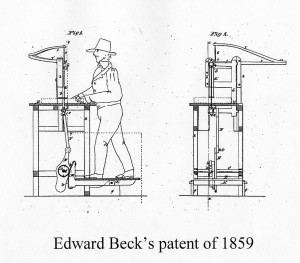In the early 1800’s with the advent of line shafts that were utilized to transmit power from water power wheels and later steam engines, advancements were made in the design and manufacturing of the machinery that would later be found in many of the foot powered machines.
It was not until just before the Civil War that early patents for foot powered machinery began to appear and most were for “improvements” in that the basic lathe and saw had been around for a long time and themselves could not be patented.
The “Modern Era” of commercially available foot powered machinery really began after the Civil War and likely both benefited from and was impacted by the war effort. Most of the focus during the war would have likely been on war materials and the manufacturing processes needed to speed production and increase efficiency. After the war was over, people could look to putting what was learned to work.
Some of these early designs claimed to be able to “multiply energy” through the use of all kinds of gears, pulleys and linkages in their machines to differentiate themselves from the competition. While some manufacturers very likely knew these claims were not true, you do get a sense of power when a flywheel or a treadle is used in the power process. In reality, all these complicated methods actually took more energy away through friction and start & stop motion.
Early patents were filed by Mathaus Kaefer, Edward Beck, Joseph Talpey, George Parr and Edward & Nenry Hassenflug. While these patents exist, so far no know examples of these early machines have been found.
Edward Beck’s patent used an “oscillating platform” where the operator rocked back and forth on a “see saw” platform that provided the power. How would you like to try coordinating rocking and pushing the wood all at the same time?
Baldwin (S.K. & N.H.) of Laconia, NH began offering “portable lathes” by about 1868 and issued a catalog showing a wide selection of metal and wood turning lathes, a scroll saw, circular saw and hand planer. They even offered a scroll sawing attachment for the lathes that would make it the first multi tools or “Shopsmith” style machine.
W.F. & John Barnes began experimenting with a scroll saw about that same time in Rockford IL and began offering their “Large Saw” (precursor of the #7 scroll saw) by 1870.
By the mid 1870’s there were a number of firms offering commercial as well as amateur/hobby grade machines. Among the more successful of these were Beach, Brown, Cady, Marston, Trump, Miller Falls and Shipman. Likely some of the drive in this period was because of the 1876 Exposition which was a great place to demonstrate and market their products. Please see the section on “Manufacturers” for more information on individual companies and the machines they made.
These commercially made machines were characterized by ornate and flowing designs influenced by the Victorian age. In addition, they were typically decorated with colorful pin striping and were almost works of art.
While records are sketchy at best related to manufacturers and how many pieces of machinery were made, we think we can safely say that well over 100 companies likely made this machinery and in total, there were easily well over 100,000 pieces manufactured.
Machines offered in Two Basic Categories
